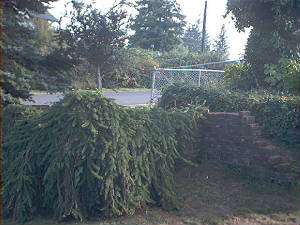
Photo we took on our way from Western WA to Eastern Wa and passing by the Tulip Fields at Mossyrock,Washington; DeGoede Bulb Farm & Gardens.
Read more about our trip at our BayTower House blog.

 Work in progress as Sweetie has dug out the 'elevated' bed (translated to big pile of dirt, lined by boulders, overgrown with ivy and other assorted unasked for and undesireable volunteer growth). It is hard to make out in this photo, but the wall he has lined with boulders is the heighth of the dirt mound (elevated bed). The neighbor's yard right behind is about level with the bottom layer of the boulder wall. Sweetie has begun digging away and in a matter of a couple of days will haul most of that dirt away. While we weren't able to do away with the 'elevated' beds, he was able to seriously dent it and push it back away from the front door entrance leaving enough room for us to do a bit of landscaping and comfortably walk around to the back (more literally, the side) of the house.
Work in progress as Sweetie has dug out the 'elevated' bed (translated to big pile of dirt, lined by boulders, overgrown with ivy and other assorted unasked for and undesireable volunteer growth). It is hard to make out in this photo, but the wall he has lined with boulders is the heighth of the dirt mound (elevated bed). The neighbor's yard right behind is about level with the bottom layer of the boulder wall. Sweetie has begun digging away and in a matter of a couple of days will haul most of that dirt away. While we weren't able to do away with the 'elevated' beds, he was able to seriously dent it and push it back away from the front door entrance leaving enough room for us to do a bit of landscaping and comfortably walk around to the back (more literally, the side) of the house.























 Work in progress as Sweetie has dug out the 'elevated' bed (translated to big pile of dirt, lined by boulders, overgrown with ivy and other assorted unasked for and undesireable volunteer growth). It is hard to make out in this photo, but the wall he has lined with boulders is the heighth of the dirt mound (elevated bed). The neighbor's yard right behind is about level with the bottom layer of the boulder wall. Sweetie has begun digging away and in a matter of a couple of days will haul most of that dirt away. While we weren't able to do away with the 'elevated' beds, he was able to seriously dent it and push it back away from the front door entrance leaving enough room for us to do a bit of landscaping and comfortably walk around to the back (more literally, the side) of the house.
Work in progress as Sweetie has dug out the 'elevated' bed (translated to big pile of dirt, lined by boulders, overgrown with ivy and other assorted unasked for and undesireable volunteer growth). It is hard to make out in this photo, but the wall he has lined with boulders is the heighth of the dirt mound (elevated bed). The neighbor's yard right behind is about level with the bottom layer of the boulder wall. Sweetie has begun digging away and in a matter of a couple of days will haul most of that dirt away. While we weren't able to do away with the 'elevated' beds, he was able to seriously dent it and push it back away from the front door entrance leaving enough room for us to do a bit of landscaping and comfortably walk around to the back (more literally, the side) of the house.















her husband built an official upside-down-tomato-grower's-structure of sorts.
